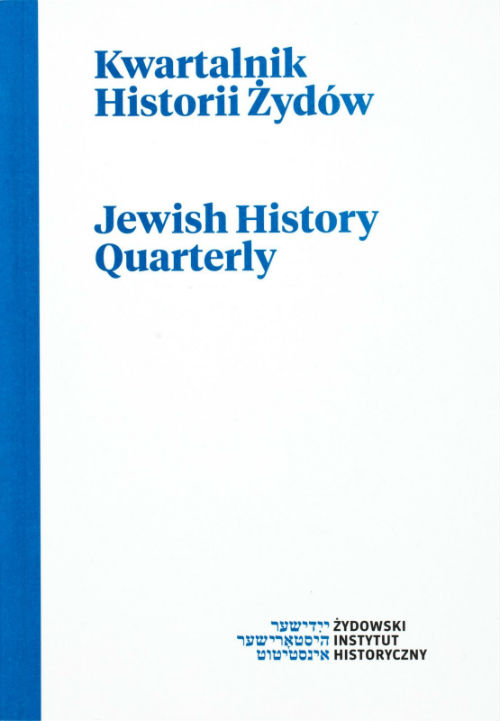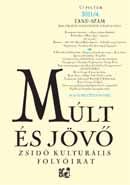
We kindly inform you that, as long as the subject affiliation of our 300.000+ articles is in progress, you might get unsufficient or no results on your third level or second level search. In this case, please broaden your search criteria.


Review of periodicals: "L'Arche", "Forverts", "Der yiddisher tam tam", "Outlook", "Shofar", "Yad Vashem Magazine", "Yad Vashem Studies", "YIVO News".
More...
Michael K. Silber´s essay ´The Historical Experience of German Jewry and its Impact on Haskalah and Reform in Hungary´ is illuminating in its exploration of the original connection that linked Hungarian to German Jewry.
More...
Before the coming to power of Hitler, ever since the appearance of Moses Mendelssohn, the German capital was one of the most important centers of Jewish science and literature.
More...
An essay by Vilmos Voigt draws a picture of the tasks awaiting researchers of Hungarian Jewish folklore.
More...
Pál Várnai's Nowhere at Home, Everywhere at Home is part of an autobiography. It is about the generation of Jews, who taking advantage of the revolution, fled from the country further dividing the remnant of Hungarian Jewry.
More...
A significant comprehensive study of György Haraszti drawing a picture of the Hungarian Jewry (or at least what was left of it) from the distance of fifty years, of the post-war years until a new turning point: the revolution of 1956.
More...
The year 2008 is not only the anniversary of the dawn of political transformation, but also the 60th anniversary of establishment of the State of Israel. It is a topic we plan to discuss over the coming year. Our main concern is the role of Hungarians who took part in this unique historical phenomenon. This present issue already gives a taste of our future program: Max Nordau, one of the founding fathers of Zionism was born in Budapest (just like Theodore Herzl) and also completed his education here. Steven Aschheim's article compares the way Nordau and Nietzsche gave answers to the basic challenges at the turn of the century.
More...
Homecoming (Interview with Ágnes Heller – the second seven years, or complementary interview and additional book chapter to the new edition of Biciklizô majom)
More...
A falusi zsidók kiszántásával megürült hely betöltésének végzetes történetébôl, cigányok és zsidók eltérô szerepébôl, s kitaszíttatásuk eltérô okaiból eredô tanulságok levonását nem lehet megspórolni. A magyar falu (vidék) pusztulásának ugyanis, amelynek szimptómáival most szembesülünk, itt van az igazi gyökere – állítja Kôbányai János.
More...
A magyar zsidóság kivételességérôl1 és külön sorsáról nagyszámú és sokirányú elemzés született. Nemkülönben a „különös házasságról”: magyarok és zsidók viszonyáról. Majd mindegyik elemzés azt kutatta – nem is tehetett mást a történet végének ismeretében –, hogy az egyetemes zsidóság történetében az egyik legsikeresebb asszimilációs kísérlet miért végzôdött ott, ahol? Mi volt az az ok, mi az a rejtelmes idegenség, ami útját állta, hogy a zsidók teljes értékû magyarok legyenek? Abban a népben, társadalomban, amely etnikailag és kulturálisan annyi fajta népet és vallást integrált magába sikeresen – mintegy túlélése zálogául. Az asszimiláció miért épp annak a népnek nem sikerült, amely éppen a leginkább erre volt kondicionálva? Hiszen egyedül éppen ô mögötte nem állt egy vele azonos nyelvet és kultúrát magáénak valló ország. Azaz: nem létezett egy olyan politikai, gazdasági vagy kulturális erôtér, amely számukra a magyarsággal szemben alternatívát nyújthatott volna. A legtöbb kutató a zsidó vallásból, a zsidó múltból eredeztette ezt az okot, amelynek begyökerezett örökségét egy-két generáció nem vetkezhette le, s a történelmi idô pedig nem adott módot erre újabb nemzedékeknek, hogy nyomtalanul felszívódjanak.
More...
Közel tíz év telt el a „magyar” irodalmi Nobeldíj hírének becsapódása óta, amelynek hatására, itt, jeruzsálemi íróasztalomnál, belevetettem magamat a megtérítô – és megtérésemet elô is idézô – Kertész Imre-olvasásba. (Lásd eredményének lenyomatait: Jób könyve és Kertésznapló címû köteteimet, Budapest, 2003.) S most nem kis nosztalgiával állapíthatom meg, hogy ismét visszatért az akkor megízlelt bódító, hatalmába ejtô érzés. Csupán száz méterre akkori lakásomtól, még mindig (meddig?) a Szent városban, s még mindig ugyanarra a Gyehenna-völgyre nézô – de már közben a Júdeai-sivatag tágas horizontját egy betonfalszalaggal lehatárolt – panoráma hátterében. Most is ugyanúgy adom át magamat a ritka szellemi kihívásnak, befogadásnak és az abból kirajzó asszociációknak, gondolatoknak, amelyek azt a Múlt és Jövô indulásakor megjelent Gályanapló- részlet gondolatát ismétlik és visszhangozzák más és más fény- és gondolattörésben: „Változtasd meg élted!” (Csak itt szerepel, nem tudom, miért: a kanonizált könyvbe nem nyert felvételt.)
More...
Az 50. évfordulójához érkezett Izrael Fesztivál Kesszáriából (Caesareából) indult 1961-ben afféle tavaszi/nyári programként, hogy 1982-ben Jeruzsálembe költözve fokozatosan a világ és Izrael mûvészei közötti kulturális párbeszéddé alakuljon át. A közönség oldaláról pedig: a Kö zel- Kelet partjaira sodródott európai mûveltségû „törzsek” kulturális igényeit egyszer egy évben egy jó erôs dózissal kielégítse – és mindezzel párhuzamban a más, az afrikai és ázsiai kontinenseken maradt illetve ott szérszóródott „törzsek” visszatérôivel ezen a bázison nyisson új diskurzust – hogy beteljesítse a régi-új Izrael legfontosabb társadalmi kihívását: néhány generáción belül alkotó sokszínûségben oldja fel a kulturális¸szokások megosztó vagy vonzó különbözôségét.
More...